Analyzing Strategic Responses to Terrorism in African Airlines
VerifiedAdded on 2020/04/01
|10
|3889
|171
AI Summary
The paper delves into the significant globalization challenges confronting African airlines, particularly Kenya Airways (KQ) and South Africa Airways (SAA). The foremost concern identified is terrorism, which significantly impacts airline operations and perceptions of safety. This analysis discusses how both airlines have strategically responded to mitigate such risks. Key strategies include enhancing security frameworks to ensure flight safety following incidents like the crash in Cameroon. Additionally, these airlines have formed strategic partnerships to counteract competitive pressures and expand their route networks, thereby adapting to changing market demands. The analysis draws on various scholarly sources that provide insights into strategic management practices and how they are tailored to address specific challenges within the airline industry.
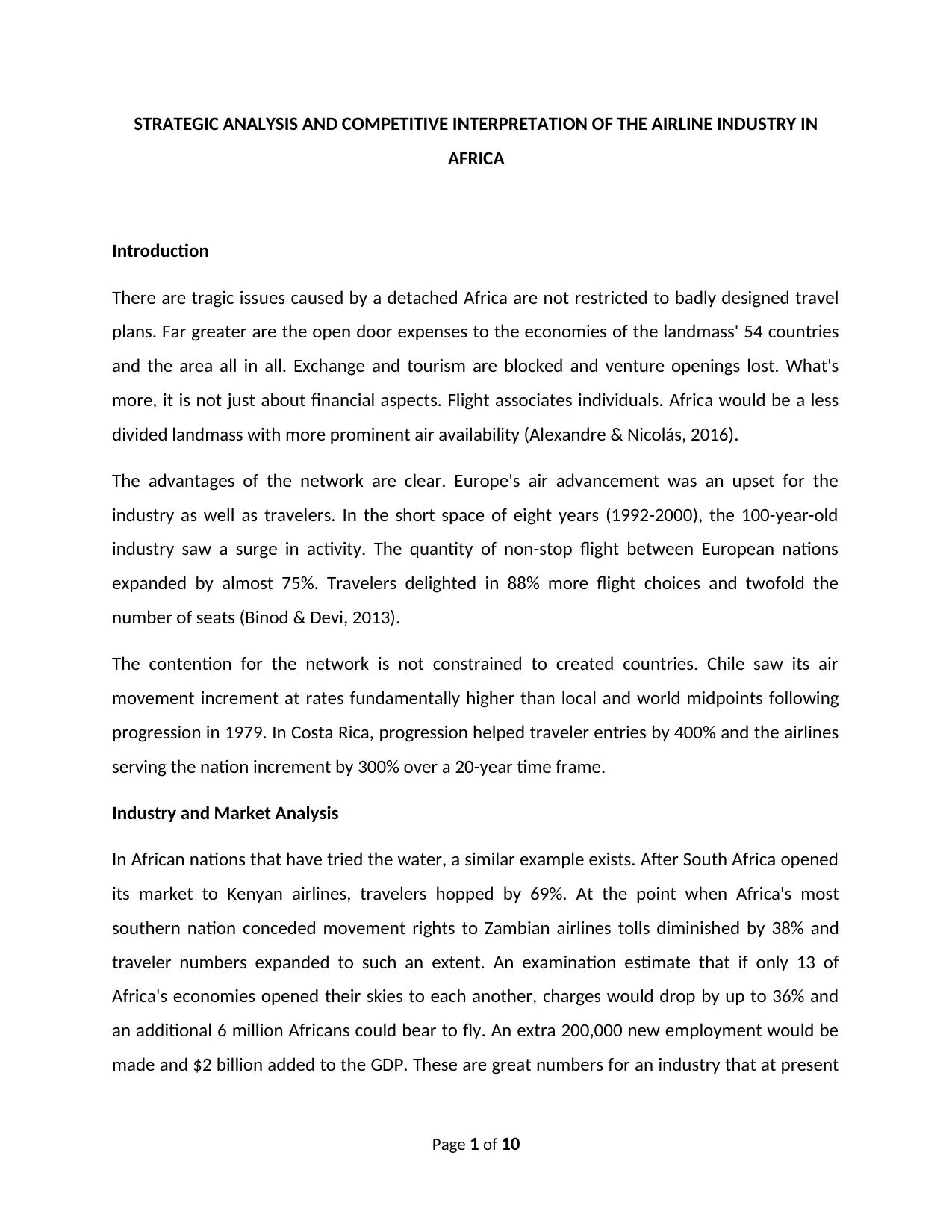
STRATEGIC ANALYSIS AND COMPETITIVE INTERPRETATION OF THE AIRLINE INDUSTRY IN
AFRICA
Introduction
There are tragic issues caused by a detached Africa are not restricted to badly designed travel
plans. Far greater are the open door expenses to the economies of the landmass' 54 countries
and the area all in all. Exchange and tourism are blocked and venture openings lost. What's
more, it is not just about financial aspects. Flight associates individuals. Africa would be a less
divided landmass with more prominent air availability (Alexandre & Nicolás, 2016).
The advantages of the network are clear. Europe's air advancement was an upset for the
industry as well as travelers. In the short space of eight years (1992-2000), the 100-year-old
industry saw a surge in activity. The quantity of non-stop flight between European nations
expanded by almost 75%. Travelers delighted in 88% more flight choices and twofold the
number of seats (Binod & Devi, 2013).
The contention for the network is not constrained to created countries. Chile saw its air
movement increment at rates fundamentally higher than local and world midpoints following
progression in 1979. In Costa Rica, progression helped traveler entries by 400% and the airlines
serving the nation increment by 300% over a 20-year time frame.
Industry and Market Analysis
In African nations that have tried the water, a similar example exists. After South Africa opened
its market to Kenyan airlines, travelers hopped by 69%. At the point when Africa's most
southern nation conceded movement rights to Zambian airlines tolls diminished by 38% and
traveler numbers expanded to such an extent. An examination estimate that if only 13 of
Africa's economies opened their skies to each another, charges would drop by up to 36% and
an additional 6 million Africans could bear to fly. An extra 200,000 new employment would be
made and $2 billion added to the GDP. These are great numbers for an industry that at present
Page 1 of 10
AFRICA
Introduction
There are tragic issues caused by a detached Africa are not restricted to badly designed travel
plans. Far greater are the open door expenses to the economies of the landmass' 54 countries
and the area all in all. Exchange and tourism are blocked and venture openings lost. What's
more, it is not just about financial aspects. Flight associates individuals. Africa would be a less
divided landmass with more prominent air availability (Alexandre & Nicolás, 2016).
The advantages of the network are clear. Europe's air advancement was an upset for the
industry as well as travelers. In the short space of eight years (1992-2000), the 100-year-old
industry saw a surge in activity. The quantity of non-stop flight between European nations
expanded by almost 75%. Travelers delighted in 88% more flight choices and twofold the
number of seats (Binod & Devi, 2013).
The contention for the network is not constrained to created countries. Chile saw its air
movement increment at rates fundamentally higher than local and world midpoints following
progression in 1979. In Costa Rica, progression helped traveler entries by 400% and the airlines
serving the nation increment by 300% over a 20-year time frame.
Industry and Market Analysis
In African nations that have tried the water, a similar example exists. After South Africa opened
its market to Kenyan airlines, travelers hopped by 69%. At the point when Africa's most
southern nation conceded movement rights to Zambian airlines tolls diminished by 38% and
traveler numbers expanded to such an extent. An examination estimate that if only 13 of
Africa's economies opened their skies to each another, charges would drop by up to 36% and
an additional 6 million Africans could bear to fly. An extra 200,000 new employment would be
made and $2 billion added to the GDP. These are great numbers for an industry that at present
Page 1 of 10
Paraphrase This Document
Need a fresh take? Get an instant paraphrase of this document with our AI Paraphraser
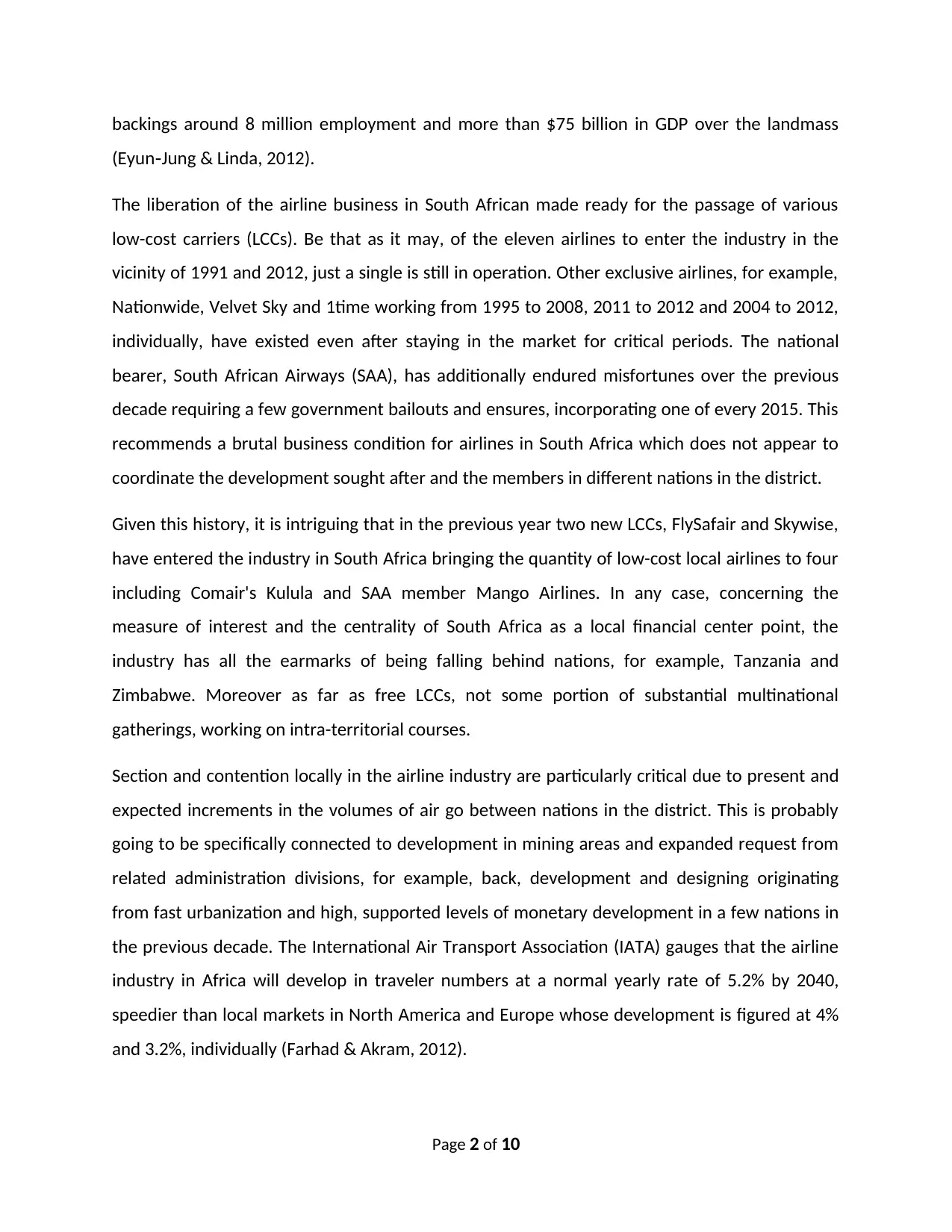
backings around 8 million employment and more than $75 billion in GDP over the landmass
(Eyun Jung & Linda, 2012).‐
The liberation of the airline business in South African made ready for the passage of various
low-cost carriers (LCCs). Be that as it may, of the eleven airlines to enter the industry in the
vicinity of 1991 and 2012, just a single is still in operation. Other exclusive airlines, for example,
Nationwide, Velvet Sky and 1time working from 1995 to 2008, 2011 to 2012 and 2004 to 2012,
individually, have existed even after staying in the market for critical periods. The national
bearer, South African Airways (SAA), has additionally endured misfortunes over the previous
decade requiring a few government bailouts and ensures, incorporating one of every 2015. This
recommends a brutal business condition for airlines in South Africa which does not appear to
coordinate the development sought after and the members in different nations in the district.
Given this history, it is intriguing that in the previous year two new LCCs, FlySafair and Skywise,
have entered the industry in South Africa bringing the quantity of low-cost local airlines to four
including Comair's Kulula and SAA member Mango Airlines. In any case, concerning the
measure of interest and the centrality of South Africa as a local financial center point, the
industry has all the earmarks of being falling behind nations, for example, Tanzania and
Zimbabwe. Moreover as far as free LCCs, not some portion of substantial multinational
gatherings, working on intra-territorial courses.
Section and contention locally in the airline industry are particularly critical due to present and
expected increments in the volumes of air go between nations in the district. This is probably
going to be specifically connected to development in mining areas and expanded request from
related administration divisions, for example, back, development and designing originating
from fast urbanization and high, supported levels of monetary development in a few nations in
the previous decade. The International Air Transport Association (IATA) gauges that the airline
industry in Africa will develop in traveler numbers at a normal yearly rate of 5.2% by 2040,
speedier than local markets in North America and Europe whose development is figured at 4%
and 3.2%, individually (Farhad & Akram, 2012).
Page 2 of 10
(Eyun Jung & Linda, 2012).‐
The liberation of the airline business in South African made ready for the passage of various
low-cost carriers (LCCs). Be that as it may, of the eleven airlines to enter the industry in the
vicinity of 1991 and 2012, just a single is still in operation. Other exclusive airlines, for example,
Nationwide, Velvet Sky and 1time working from 1995 to 2008, 2011 to 2012 and 2004 to 2012,
individually, have existed even after staying in the market for critical periods. The national
bearer, South African Airways (SAA), has additionally endured misfortunes over the previous
decade requiring a few government bailouts and ensures, incorporating one of every 2015. This
recommends a brutal business condition for airlines in South Africa which does not appear to
coordinate the development sought after and the members in different nations in the district.
Given this history, it is intriguing that in the previous year two new LCCs, FlySafair and Skywise,
have entered the industry in South Africa bringing the quantity of low-cost local airlines to four
including Comair's Kulula and SAA member Mango Airlines. In any case, concerning the
measure of interest and the centrality of South Africa as a local financial center point, the
industry has all the earmarks of being falling behind nations, for example, Tanzania and
Zimbabwe. Moreover as far as free LCCs, not some portion of substantial multinational
gatherings, working on intra-territorial courses.
Section and contention locally in the airline industry are particularly critical due to present and
expected increments in the volumes of air go between nations in the district. This is probably
going to be specifically connected to development in mining areas and expanded request from
related administration divisions, for example, back, development and designing originating
from fast urbanization and high, supported levels of monetary development in a few nations in
the previous decade. The International Air Transport Association (IATA) gauges that the airline
industry in Africa will develop in traveler numbers at a normal yearly rate of 5.2% by 2040,
speedier than local markets in North America and Europe whose development is figured at 4%
and 3.2%, individually (Farhad & Akram, 2012).
Page 2 of 10
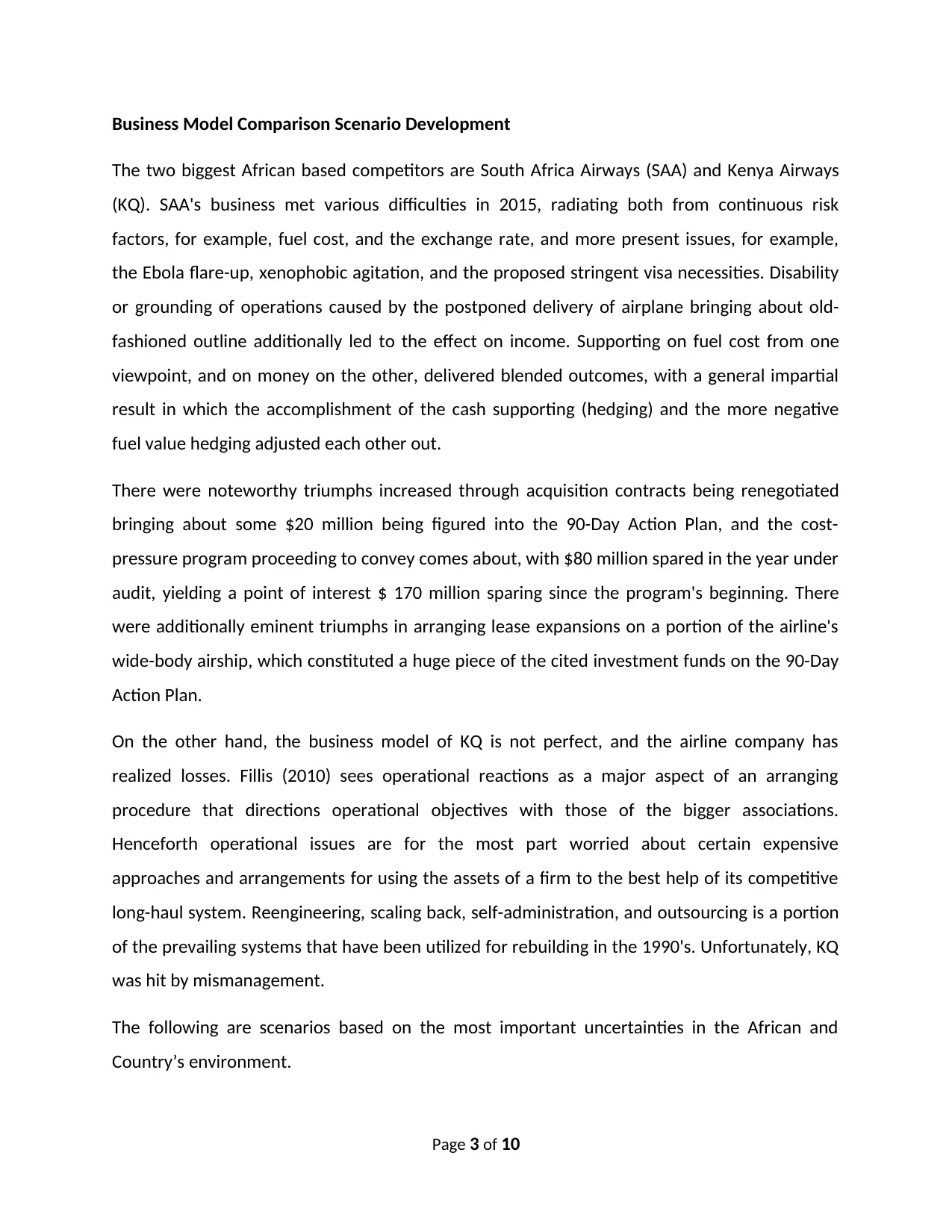
Business Model Comparison Scenario Development
The two biggest African based competitors are South Africa Airways (SAA) and Kenya Airways
(KQ). SAA's business met various difficulties in 2015, radiating both from continuous risk
factors, for example, fuel cost, and the exchange rate, and more present issues, for example,
the Ebola flare-up, xenophobic agitation, and the proposed stringent visa necessities. Disability
or grounding of operations caused by the postponed delivery of airplane bringing about old-
fashioned outline additionally led to the effect on income. Supporting on fuel cost from one
viewpoint, and on money on the other, delivered blended outcomes, with a general impartial
result in which the accomplishment of the cash supporting (hedging) and the more negative
fuel value hedging adjusted each other out.
There were noteworthy triumphs increased through acquisition contracts being renegotiated
bringing about some $20 million being figured into the 90-Day Action Plan, and the cost-
pressure program proceeding to convey comes about, with $80 million spared in the year under
audit, yielding a point of interest $ 170 million sparing since the program's beginning. There
were additionally eminent triumphs in arranging lease expansions on a portion of the airline's
wide-body airship, which constituted a huge piece of the cited investment funds on the 90-Day
Action Plan.
On the other hand, the business model of KQ is not perfect, and the airline company has
realized losses. Fillis (2010) sees operational reactions as a major aspect of an arranging
procedure that directions operational objectives with those of the bigger associations.
Henceforth operational issues are for the most part worried about certain expensive
approaches and arrangements for using the assets of a firm to the best help of its competitive
long-haul system. Reengineering, scaling back, self-administration, and outsourcing is a portion
of the prevailing systems that have been utilized for rebuilding in the 1990's. Unfortunately, KQ
was hit by mismanagement.
The following are scenarios based on the most important uncertainties in the African and
Country’s environment.
Page 3 of 10
The two biggest African based competitors are South Africa Airways (SAA) and Kenya Airways
(KQ). SAA's business met various difficulties in 2015, radiating both from continuous risk
factors, for example, fuel cost, and the exchange rate, and more present issues, for example,
the Ebola flare-up, xenophobic agitation, and the proposed stringent visa necessities. Disability
or grounding of operations caused by the postponed delivery of airplane bringing about old-
fashioned outline additionally led to the effect on income. Supporting on fuel cost from one
viewpoint, and on money on the other, delivered blended outcomes, with a general impartial
result in which the accomplishment of the cash supporting (hedging) and the more negative
fuel value hedging adjusted each other out.
There were noteworthy triumphs increased through acquisition contracts being renegotiated
bringing about some $20 million being figured into the 90-Day Action Plan, and the cost-
pressure program proceeding to convey comes about, with $80 million spared in the year under
audit, yielding a point of interest $ 170 million sparing since the program's beginning. There
were additionally eminent triumphs in arranging lease expansions on a portion of the airline's
wide-body airship, which constituted a huge piece of the cited investment funds on the 90-Day
Action Plan.
On the other hand, the business model of KQ is not perfect, and the airline company has
realized losses. Fillis (2010) sees operational reactions as a major aspect of an arranging
procedure that directions operational objectives with those of the bigger associations.
Henceforth operational issues are for the most part worried about certain expensive
approaches and arrangements for using the assets of a firm to the best help of its competitive
long-haul system. Reengineering, scaling back, self-administration, and outsourcing is a portion
of the prevailing systems that have been utilized for rebuilding in the 1990's. Unfortunately, KQ
was hit by mismanagement.
The following are scenarios based on the most important uncertainties in the African and
Country’s environment.
Page 3 of 10
⊘ This is a preview!⊘
Do you want full access?
Subscribe today to unlock all pages.

Trusted by 1+ million students worldwide

Scenario 1: Exchange Rate Fluctuation
The worldwide idea of the airline industry implies that airlines are presented to chances of cash
change. Most carriers bring about the two costs and incomes in various monetary standards
and the way that some of these money flows require transformation into an alternate cash
forms the premise of an airline's foreign exchange (FX) risk.
Vast developments in exchange rates affect airlines through three primary channels; buyer
choices (request/demand), airline choices (supply) and monetary effects. Of these, the
customer (request) reaction to a huge move in relative costs can be quick and may provoke a
reaction from airlines, including changes by limit (supply). The monetary effect can be
particularly intense for airlines when it identifies with sizeable changes in the estimation of the
US dollar (as has been the situation in recent months or somewhere in the vicinity).
This is because a vast extent of airline costs (counting fuel) are named in US dollars, and
numerous carriers need to change over household cash into dollars every year to meet their
commitments. This offers to ascend to FX chance. Extensive cash developments can likewise
convolute the assignment of looking at and collecting budgetary factors over the industry.
Redressing for such developments is basic to guarantee that bends are expelled, and hidden
money related execution is broken down (Hsu, 2011).
Scenario 2: Fluctuating Interest Rates
Many senior officials comprehend that unstable exchange rates can influence the dollar
estimation of their organizations' benefits and liabilities designated in foreign monetary forms.
Very few, in any case, comprehend that exchange rates can seriously affect working benefit.
Fewer companies have given chiefs obligation regarding regulating this working introduction.
The working presentation is regularly a vast reason for fluctuation in working benefit from year
to year, and numerous choices rely upon a decent comprehension of it.
Over the long haul, directors ought to consider working introduction when setting strategy and
overall item arranging. In the short run, understanding working presentation will frequently
enhance working choices. Additionally, the assessment of a specialty unit and its directors
Page 4 of 10
The worldwide idea of the airline industry implies that airlines are presented to chances of cash
change. Most carriers bring about the two costs and incomes in various monetary standards
and the way that some of these money flows require transformation into an alternate cash
forms the premise of an airline's foreign exchange (FX) risk.
Vast developments in exchange rates affect airlines through three primary channels; buyer
choices (request/demand), airline choices (supply) and monetary effects. Of these, the
customer (request) reaction to a huge move in relative costs can be quick and may provoke a
reaction from airlines, including changes by limit (supply). The monetary effect can be
particularly intense for airlines when it identifies with sizeable changes in the estimation of the
US dollar (as has been the situation in recent months or somewhere in the vicinity).
This is because a vast extent of airline costs (counting fuel) are named in US dollars, and
numerous carriers need to change over household cash into dollars every year to meet their
commitments. This offers to ascend to FX chance. Extensive cash developments can likewise
convolute the assignment of looking at and collecting budgetary factors over the industry.
Redressing for such developments is basic to guarantee that bends are expelled, and hidden
money related execution is broken down (Hsu, 2011).
Scenario 2: Fluctuating Interest Rates
Many senior officials comprehend that unstable exchange rates can influence the dollar
estimation of their organizations' benefits and liabilities designated in foreign monetary forms.
Very few, in any case, comprehend that exchange rates can seriously affect working benefit.
Fewer companies have given chiefs obligation regarding regulating this working introduction.
The working presentation is regularly a vast reason for fluctuation in working benefit from year
to year, and numerous choices rely upon a decent comprehension of it.
Over the long haul, directors ought to consider working introduction when setting strategy and
overall item arranging. In the short run, understanding working presentation will frequently
enhance working choices. Additionally, the assessment of a specialty unit and its directors
Page 4 of 10
Paraphrase This Document
Need a fresh take? Get an instant paraphrase of this document with our AI Paraphraser
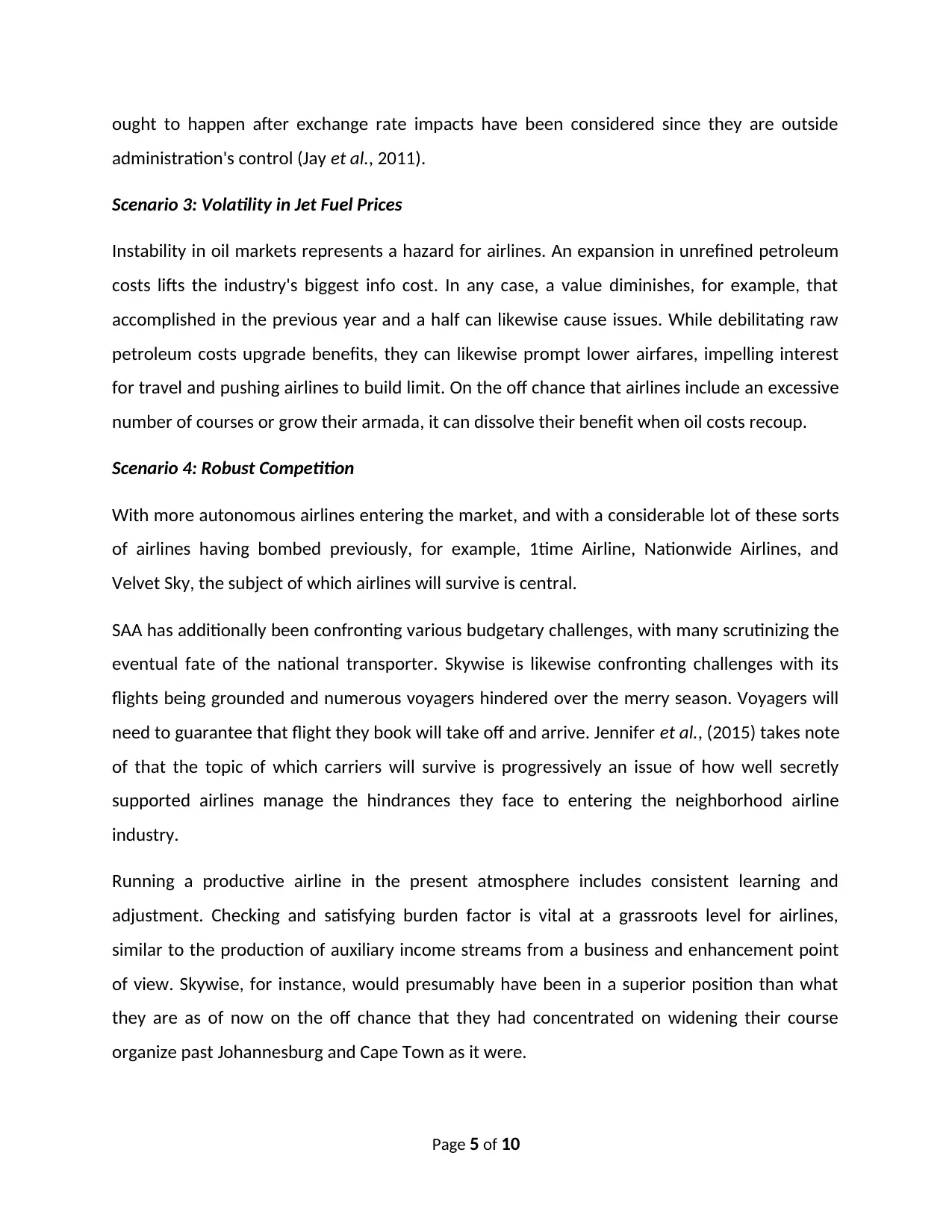
ought to happen after exchange rate impacts have been considered since they are outside
administration's control (Jay et al., 2011).
Scenario 3: Volatility in Jet Fuel Prices
Instability in oil markets represents a hazard for airlines. An expansion in unrefined petroleum
costs lifts the industry's biggest info cost. In any case, a value diminishes, for example, that
accomplished in the previous year and a half can likewise cause issues. While debilitating raw
petroleum costs upgrade benefits, they can likewise prompt lower airfares, impelling interest
for travel and pushing airlines to build limit. On the off chance that airlines include an excessive
number of courses or grow their armada, it can dissolve their benefit when oil costs recoup.
Scenario 4: Robust Competition
With more autonomous airlines entering the market, and with a considerable lot of these sorts
of airlines having bombed previously, for example, 1time Airline, Nationwide Airlines, and
Velvet Sky, the subject of which airlines will survive is central.
SAA has additionally been confronting various budgetary challenges, with many scrutinizing the
eventual fate of the national transporter. Skywise is likewise confronting challenges with its
flights being grounded and numerous voyagers hindered over the merry season. Voyagers will
need to guarantee that flight they book will take off and arrive. Jennifer et al., (2015) takes note
of that the topic of which carriers will survive is progressively an issue of how well secretly
supported airlines manage the hindrances they face to entering the neighborhood airline
industry.
Running a productive airline in the present atmosphere includes consistent learning and
adjustment. Checking and satisfying burden factor is vital at a grassroots level for airlines,
similar to the production of auxiliary income streams from a business and enhancement point
of view. Skywise, for instance, would presumably have been in a superior position than what
they are as of now on the off chance that they had concentrated on widening their course
organize past Johannesburg and Cape Town as it were.
Page 5 of 10
administration's control (Jay et al., 2011).
Scenario 3: Volatility in Jet Fuel Prices
Instability in oil markets represents a hazard for airlines. An expansion in unrefined petroleum
costs lifts the industry's biggest info cost. In any case, a value diminishes, for example, that
accomplished in the previous year and a half can likewise cause issues. While debilitating raw
petroleum costs upgrade benefits, they can likewise prompt lower airfares, impelling interest
for travel and pushing airlines to build limit. On the off chance that airlines include an excessive
number of courses or grow their armada, it can dissolve their benefit when oil costs recoup.
Scenario 4: Robust Competition
With more autonomous airlines entering the market, and with a considerable lot of these sorts
of airlines having bombed previously, for example, 1time Airline, Nationwide Airlines, and
Velvet Sky, the subject of which airlines will survive is central.
SAA has additionally been confronting various budgetary challenges, with many scrutinizing the
eventual fate of the national transporter. Skywise is likewise confronting challenges with its
flights being grounded and numerous voyagers hindered over the merry season. Voyagers will
need to guarantee that flight they book will take off and arrive. Jennifer et al., (2015) takes note
of that the topic of which carriers will survive is progressively an issue of how well secretly
supported airlines manage the hindrances they face to entering the neighborhood airline
industry.
Running a productive airline in the present atmosphere includes consistent learning and
adjustment. Checking and satisfying burden factor is vital at a grassroots level for airlines,
similar to the production of auxiliary income streams from a business and enhancement point
of view. Skywise, for instance, would presumably have been in a superior position than what
they are as of now on the off chance that they had concentrated on widening their course
organize past Johannesburg and Cape Town as it were.
Page 5 of 10
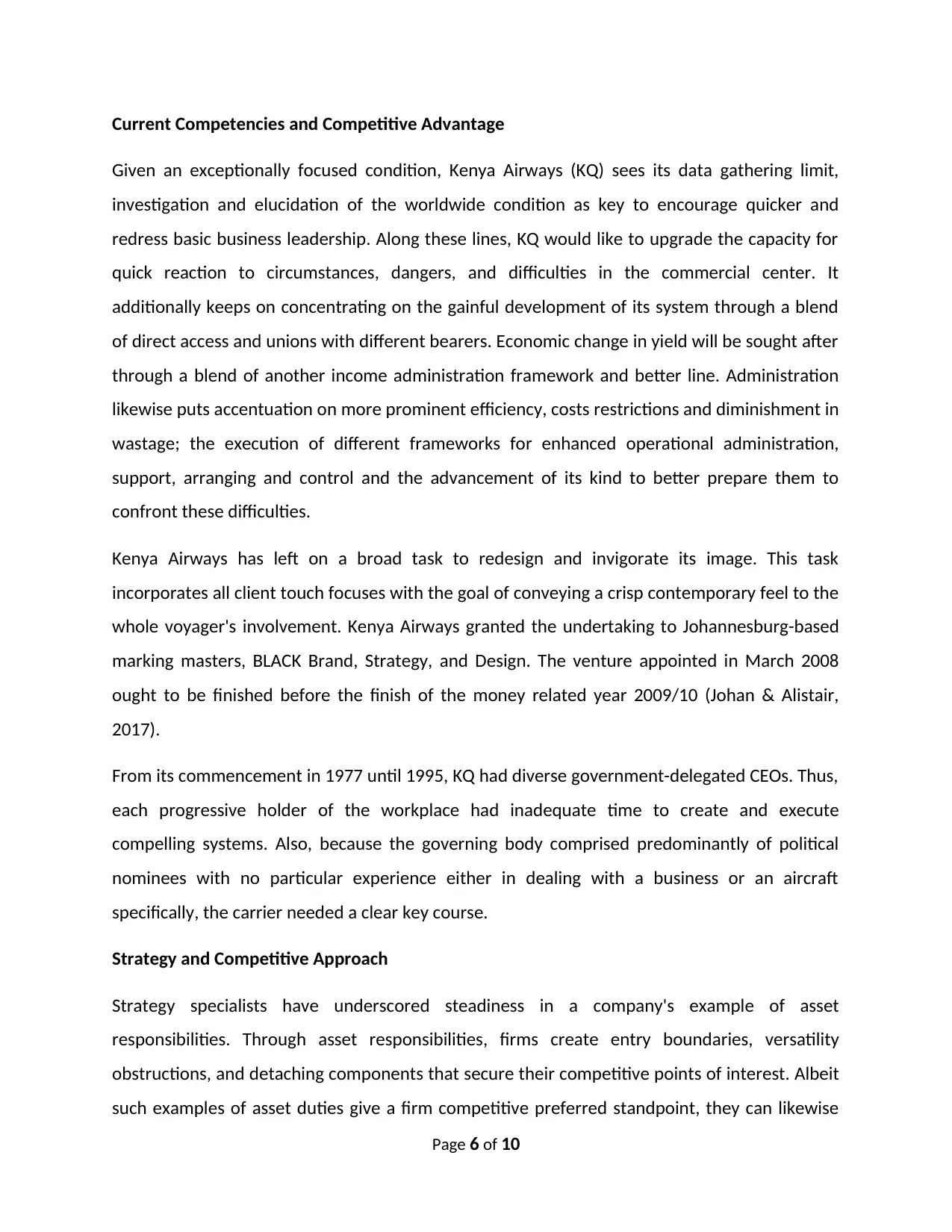
Current Competencies and Competitive Advantage
Given an exceptionally focused condition, Kenya Airways (KQ) sees its data gathering limit,
investigation and elucidation of the worldwide condition as key to encourage quicker and
redress basic business leadership. Along these lines, KQ would like to upgrade the capacity for
quick reaction to circumstances, dangers, and difficulties in the commercial center. It
additionally keeps on concentrating on the gainful development of its system through a blend
of direct access and unions with different bearers. Economic change in yield will be sought after
through a blend of another income administration framework and better line. Administration
likewise puts accentuation on more prominent efficiency, costs restrictions and diminishment in
wastage; the execution of different frameworks for enhanced operational administration,
support, arranging and control and the advancement of its kind to better prepare them to
confront these difficulties.
Kenya Airways has left on a broad task to redesign and invigorate its image. This task
incorporates all client touch focuses with the goal of conveying a crisp contemporary feel to the
whole voyager's involvement. Kenya Airways granted the undertaking to Johannesburg-based
marking masters, BLACK Brand, Strategy, and Design. The venture appointed in March 2008
ought to be finished before the finish of the money related year 2009/10 (Johan & Alistair,
2017).
From its commencement in 1977 until 1995, KQ had diverse government-delegated CEOs. Thus,
each progressive holder of the workplace had inadequate time to create and execute
compelling systems. Also, because the governing body comprised predominantly of political
nominees with no particular experience either in dealing with a business or an aircraft
specifically, the carrier needed a clear key course.
Strategy and Competitive Approach
Strategy specialists have underscored steadiness in a company's example of asset
responsibilities. Through asset responsibilities, firms create entry boundaries, versatility
obstructions, and detaching components that secure their competitive points of interest. Albeit
such examples of asset duties give a firm competitive preferred standpoint, they can likewise
Page 6 of 10
Given an exceptionally focused condition, Kenya Airways (KQ) sees its data gathering limit,
investigation and elucidation of the worldwide condition as key to encourage quicker and
redress basic business leadership. Along these lines, KQ would like to upgrade the capacity for
quick reaction to circumstances, dangers, and difficulties in the commercial center. It
additionally keeps on concentrating on the gainful development of its system through a blend
of direct access and unions with different bearers. Economic change in yield will be sought after
through a blend of another income administration framework and better line. Administration
likewise puts accentuation on more prominent efficiency, costs restrictions and diminishment in
wastage; the execution of different frameworks for enhanced operational administration,
support, arranging and control and the advancement of its kind to better prepare them to
confront these difficulties.
Kenya Airways has left on a broad task to redesign and invigorate its image. This task
incorporates all client touch focuses with the goal of conveying a crisp contemporary feel to the
whole voyager's involvement. Kenya Airways granted the undertaking to Johannesburg-based
marking masters, BLACK Brand, Strategy, and Design. The venture appointed in March 2008
ought to be finished before the finish of the money related year 2009/10 (Johan & Alistair,
2017).
From its commencement in 1977 until 1995, KQ had diverse government-delegated CEOs. Thus,
each progressive holder of the workplace had inadequate time to create and execute
compelling systems. Also, because the governing body comprised predominantly of political
nominees with no particular experience either in dealing with a business or an aircraft
specifically, the carrier needed a clear key course.
Strategy and Competitive Approach
Strategy specialists have underscored steadiness in a company's example of asset
responsibilities. Through asset responsibilities, firms create entry boundaries, versatility
obstructions, and detaching components that secure their competitive points of interest. Albeit
such examples of asset duties give a firm competitive preferred standpoint, they can likewise
Page 6 of 10
⊘ This is a preview!⊘
Do you want full access?
Subscribe today to unlock all pages.

Trusted by 1+ million students worldwide
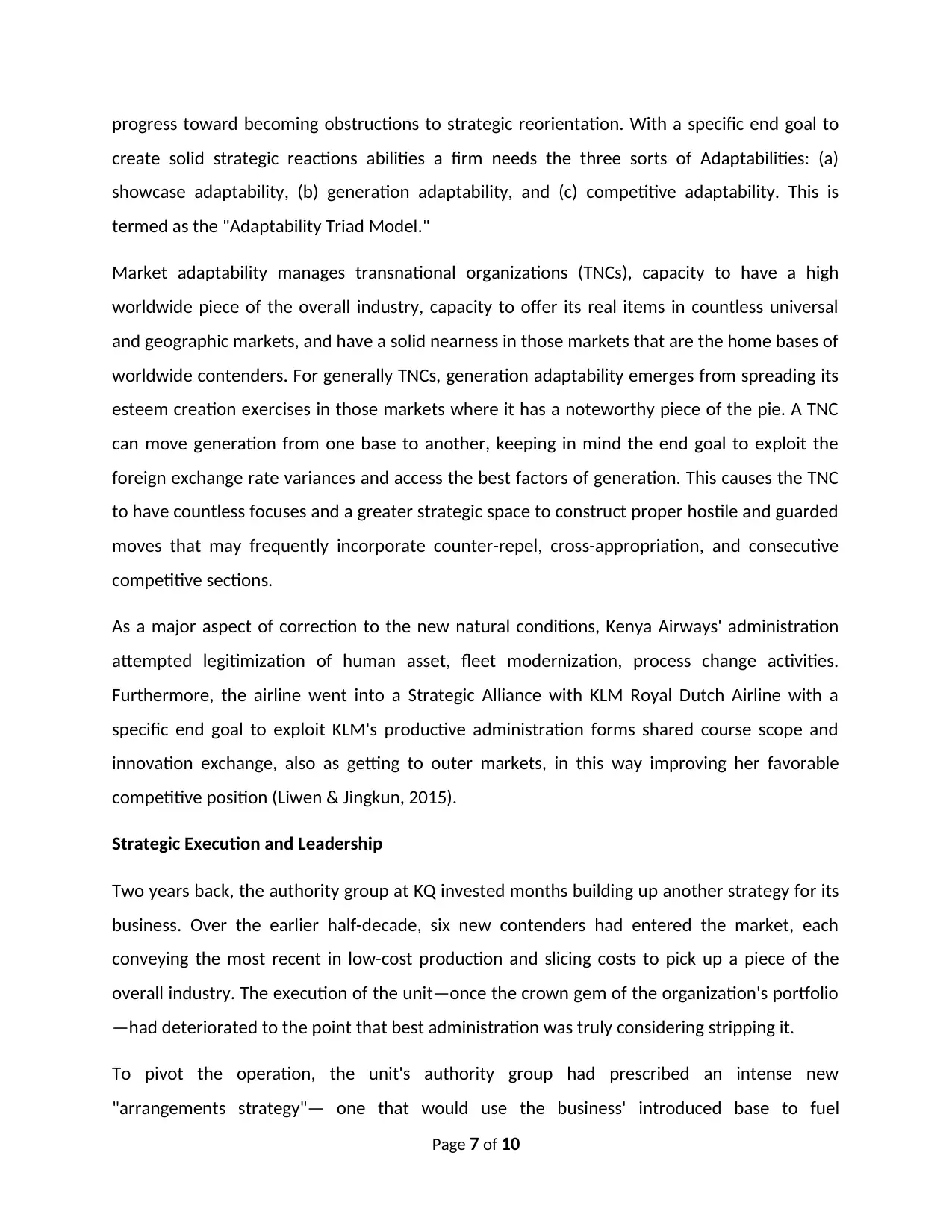
progress toward becoming obstructions to strategic reorientation. With a specific end goal to
create solid strategic reactions abilities a firm needs the three sorts of Adaptabilities: (a)
showcase adaptability, (b) generation adaptability, and (c) competitive adaptability. This is
termed as the "Adaptability Triad Model."
Market adaptability manages transnational organizations (TNCs), capacity to have a high
worldwide piece of the overall industry, capacity to offer its real items in countless universal
and geographic markets, and have a solid nearness in those markets that are the home bases of
worldwide contenders. For generally TNCs, generation adaptability emerges from spreading its
esteem creation exercises in those markets where it has a noteworthy piece of the pie. A TNC
can move generation from one base to another, keeping in mind the end goal to exploit the
foreign exchange rate variances and access the best factors of generation. This causes the TNC
to have countless focuses and a greater strategic space to construct proper hostile and guarded
moves that may frequently incorporate counter-repel, cross-appropriation, and consecutive
competitive sections.
As a major aspect of correction to the new natural conditions, Kenya Airways' administration
attempted legitimization of human asset, fleet modernization, process change activities.
Furthermore, the airline went into a Strategic Alliance with KLM Royal Dutch Airline with a
specific end goal to exploit KLM's productive administration forms shared course scope and
innovation exchange, also as getting to outer markets, in this way improving her favorable
competitive position (Liwen & Jingkun, 2015).
Strategic Execution and Leadership
Two years back, the authority group at KQ invested months building up another strategy for its
business. Over the earlier half-decade, six new contenders had entered the market, each
conveying the most recent in low-cost production and slicing costs to pick up a piece of the
overall industry. The execution of the unit—once the crown gem of the organization's portfolio
—had deteriorated to the point that best administration was truly considering stripping it.
To pivot the operation, the unit's authority group had prescribed an intense new
"arrangements strategy"— one that would use the business' introduced base to fuel
Page 7 of 10
create solid strategic reactions abilities a firm needs the three sorts of Adaptabilities: (a)
showcase adaptability, (b) generation adaptability, and (c) competitive adaptability. This is
termed as the "Adaptability Triad Model."
Market adaptability manages transnational organizations (TNCs), capacity to have a high
worldwide piece of the overall industry, capacity to offer its real items in countless universal
and geographic markets, and have a solid nearness in those markets that are the home bases of
worldwide contenders. For generally TNCs, generation adaptability emerges from spreading its
esteem creation exercises in those markets where it has a noteworthy piece of the pie. A TNC
can move generation from one base to another, keeping in mind the end goal to exploit the
foreign exchange rate variances and access the best factors of generation. This causes the TNC
to have countless focuses and a greater strategic space to construct proper hostile and guarded
moves that may frequently incorporate counter-repel, cross-appropriation, and consecutive
competitive sections.
As a major aspect of correction to the new natural conditions, Kenya Airways' administration
attempted legitimization of human asset, fleet modernization, process change activities.
Furthermore, the airline went into a Strategic Alliance with KLM Royal Dutch Airline with a
specific end goal to exploit KLM's productive administration forms shared course scope and
innovation exchange, also as getting to outer markets, in this way improving her favorable
competitive position (Liwen & Jingkun, 2015).
Strategic Execution and Leadership
Two years back, the authority group at KQ invested months building up another strategy for its
business. Over the earlier half-decade, six new contenders had entered the market, each
conveying the most recent in low-cost production and slicing costs to pick up a piece of the
overall industry. The execution of the unit—once the crown gem of the organization's portfolio
—had deteriorated to the point that best administration was truly considering stripping it.
To pivot the operation, the unit's authority group had prescribed an intense new
"arrangements strategy"— one that would use the business' introduced base to fuel
Page 7 of 10
Paraphrase This Document
Need a fresh take? Get an instant paraphrase of this document with our AI Paraphraser
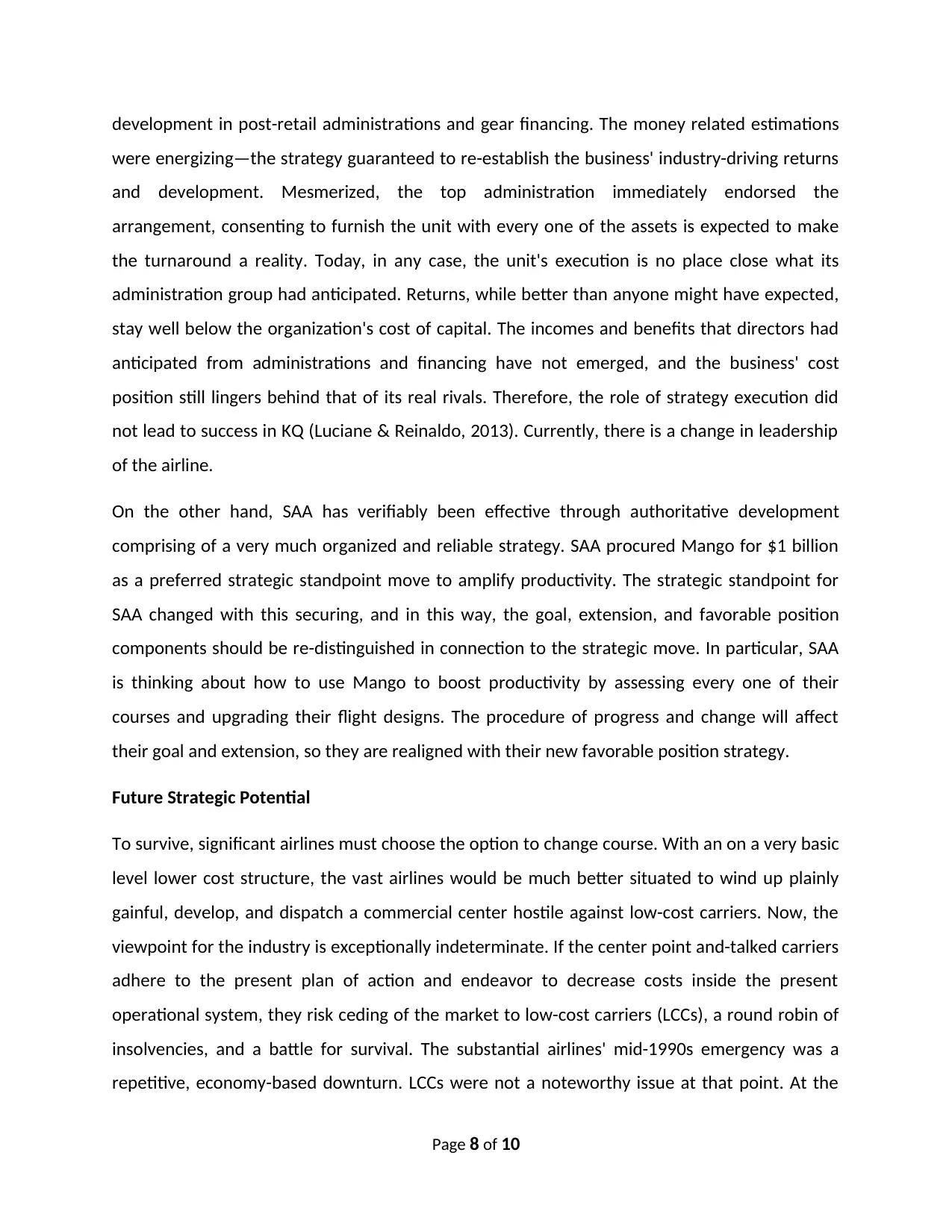
development in post-retail administrations and gear financing. The money related estimations
were energizing—the strategy guaranteed to re-establish the business' industry-driving returns
and development. Mesmerized, the top administration immediately endorsed the
arrangement, consenting to furnish the unit with every one of the assets is expected to make
the turnaround a reality. Today, in any case, the unit's execution is no place close what its
administration group had anticipated. Returns, while better than anyone might have expected,
stay well below the organization's cost of capital. The incomes and benefits that directors had
anticipated from administrations and financing have not emerged, and the business' cost
position still lingers behind that of its real rivals. Therefore, the role of strategy execution did
not lead to success in KQ (Luciane & Reinaldo, 2013). Currently, there is a change in leadership
of the airline.
On the other hand, SAA has verifiably been effective through authoritative development
comprising of a very much organized and reliable strategy. SAA procured Mango for $1 billion
as a preferred strategic standpoint move to amplify productivity. The strategic standpoint for
SAA changed with this securing, and in this way, the goal, extension, and favorable position
components should be re-distinguished in connection to the strategic move. In particular, SAA
is thinking about how to use Mango to boost productivity by assessing every one of their
courses and upgrading their flight designs. The procedure of progress and change will affect
their goal and extension, so they are realigned with their new favorable position strategy.
Future Strategic Potential
To survive, significant airlines must choose the option to change course. With an on a very basic
level lower cost structure, the vast airlines would be much better situated to wind up plainly
gainful, develop, and dispatch a commercial center hostile against low-cost carriers. Now, the
viewpoint for the industry is exceptionally indeterminate. If the center point and-talked carriers
adhere to the present plan of action and endeavor to decrease costs inside the present
operational system, they risk ceding of the market to low-cost carriers (LCCs), a round robin of
insolvencies, and a battle for survival. The substantial airlines' mid-1990s emergency was a
repetitive, economy-based downturn. LCCs were not a noteworthy issue at that point. At the
Page 8 of 10
were energizing—the strategy guaranteed to re-establish the business' industry-driving returns
and development. Mesmerized, the top administration immediately endorsed the
arrangement, consenting to furnish the unit with every one of the assets is expected to make
the turnaround a reality. Today, in any case, the unit's execution is no place close what its
administration group had anticipated. Returns, while better than anyone might have expected,
stay well below the organization's cost of capital. The incomes and benefits that directors had
anticipated from administrations and financing have not emerged, and the business' cost
position still lingers behind that of its real rivals. Therefore, the role of strategy execution did
not lead to success in KQ (Luciane & Reinaldo, 2013). Currently, there is a change in leadership
of the airline.
On the other hand, SAA has verifiably been effective through authoritative development
comprising of a very much organized and reliable strategy. SAA procured Mango for $1 billion
as a preferred strategic standpoint move to amplify productivity. The strategic standpoint for
SAA changed with this securing, and in this way, the goal, extension, and favorable position
components should be re-distinguished in connection to the strategic move. In particular, SAA
is thinking about how to use Mango to boost productivity by assessing every one of their
courses and upgrading their flight designs. The procedure of progress and change will affect
their goal and extension, so they are realigned with their new favorable position strategy.
Future Strategic Potential
To survive, significant airlines must choose the option to change course. With an on a very basic
level lower cost structure, the vast airlines would be much better situated to wind up plainly
gainful, develop, and dispatch a commercial center hostile against low-cost carriers. Now, the
viewpoint for the industry is exceptionally indeterminate. If the center point and-talked carriers
adhere to the present plan of action and endeavor to decrease costs inside the present
operational system, they risk ceding of the market to low-cost carriers (LCCs), a round robin of
insolvencies, and a battle for survival. The substantial airlines' mid-1990s emergency was a
repetitive, economy-based downturn. LCCs were not a noteworthy issue at that point. At the
Page 8 of 10
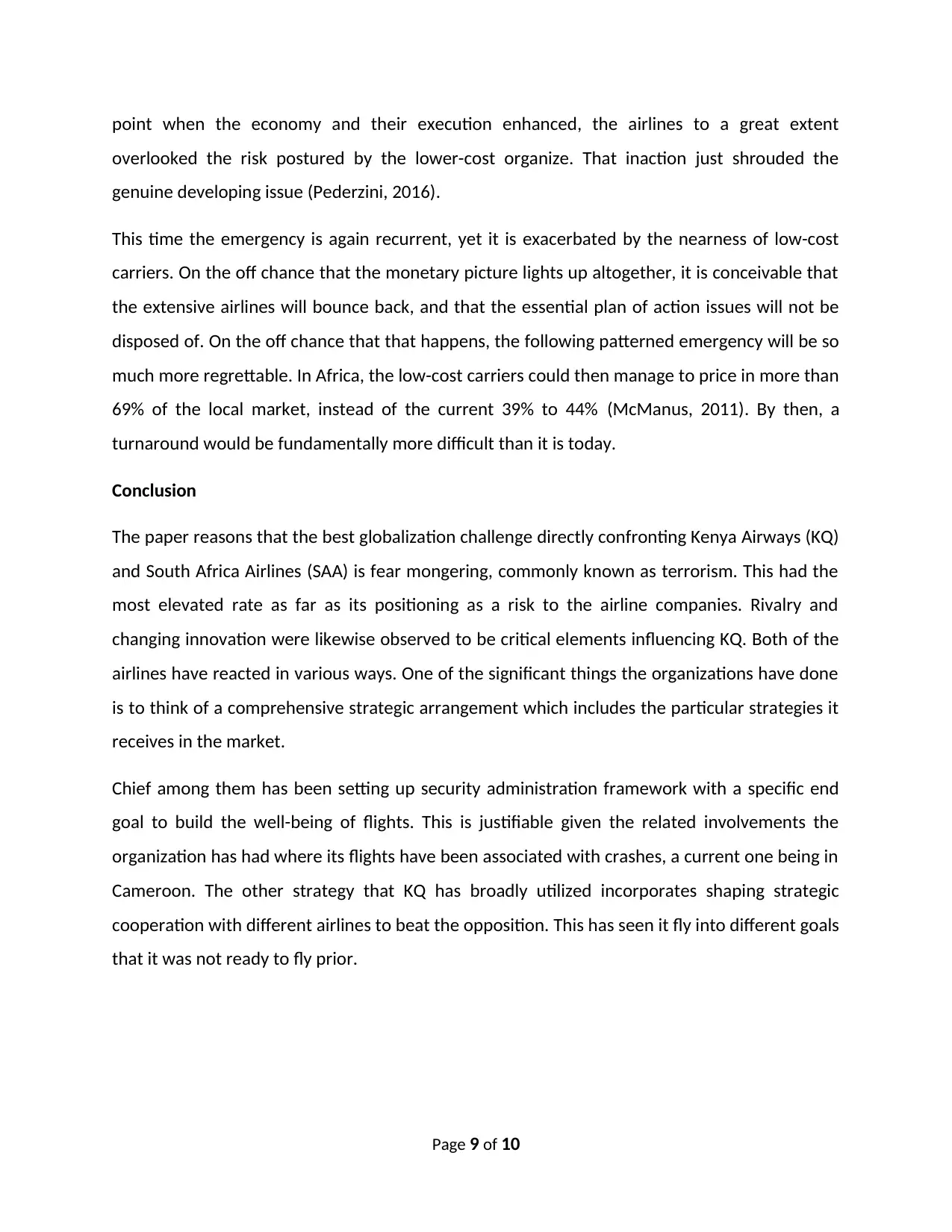
point when the economy and their execution enhanced, the airlines to a great extent
overlooked the risk postured by the lower-cost organize. That inaction just shrouded the
genuine developing issue (Pederzini, 2016).
This time the emergency is again recurrent, yet it is exacerbated by the nearness of low-cost
carriers. On the off chance that the monetary picture lights up altogether, it is conceivable that
the extensive airlines will bounce back, and that the essential plan of action issues will not be
disposed of. On the off chance that that happens, the following patterned emergency will be so
much more regrettable. In Africa, the low-cost carriers could then manage to price in more than
69% of the local market, instead of the current 39% to 44% (McManus, 2011). By then, a
turnaround would be fundamentally more difficult than it is today.
Conclusion
The paper reasons that the best globalization challenge directly confronting Kenya Airways (KQ)
and South Africa Airlines (SAA) is fear mongering, commonly known as terrorism. This had the
most elevated rate as far as its positioning as a risk to the airline companies. Rivalry and
changing innovation were likewise observed to be critical elements influencing KQ. Both of the
airlines have reacted in various ways. One of the significant things the organizations have done
is to think of a comprehensive strategic arrangement which includes the particular strategies it
receives in the market.
Chief among them has been setting up security administration framework with a specific end
goal to build the well-being of flights. This is justifiable given the related involvements the
organization has had where its flights have been associated with crashes, a current one being in
Cameroon. The other strategy that KQ has broadly utilized incorporates shaping strategic
cooperation with different airlines to beat the opposition. This has seen it fly into different goals
that it was not ready to fly prior.
Page 9 of 10
overlooked the risk postured by the lower-cost organize. That inaction just shrouded the
genuine developing issue (Pederzini, 2016).
This time the emergency is again recurrent, yet it is exacerbated by the nearness of low-cost
carriers. On the off chance that the monetary picture lights up altogether, it is conceivable that
the extensive airlines will bounce back, and that the essential plan of action issues will not be
disposed of. On the off chance that that happens, the following patterned emergency will be so
much more regrettable. In Africa, the low-cost carriers could then manage to price in more than
69% of the local market, instead of the current 39% to 44% (McManus, 2011). By then, a
turnaround would be fundamentally more difficult than it is today.
Conclusion
The paper reasons that the best globalization challenge directly confronting Kenya Airways (KQ)
and South Africa Airlines (SAA) is fear mongering, commonly known as terrorism. This had the
most elevated rate as far as its positioning as a risk to the airline companies. Rivalry and
changing innovation were likewise observed to be critical elements influencing KQ. Both of the
airlines have reacted in various ways. One of the significant things the organizations have done
is to think of a comprehensive strategic arrangement which includes the particular strategies it
receives in the market.
Chief among them has been setting up security administration framework with a specific end
goal to build the well-being of flights. This is justifiable given the related involvements the
organization has had where its flights have been associated with crashes, a current one being in
Cameroon. The other strategy that KQ has broadly utilized incorporates shaping strategic
cooperation with different airlines to beat the opposition. This has seen it fly into different goals
that it was not ready to fly prior.
Page 9 of 10
⊘ This is a preview!⊘
Do you want full access?
Subscribe today to unlock all pages.

Trusted by 1+ million students worldwide
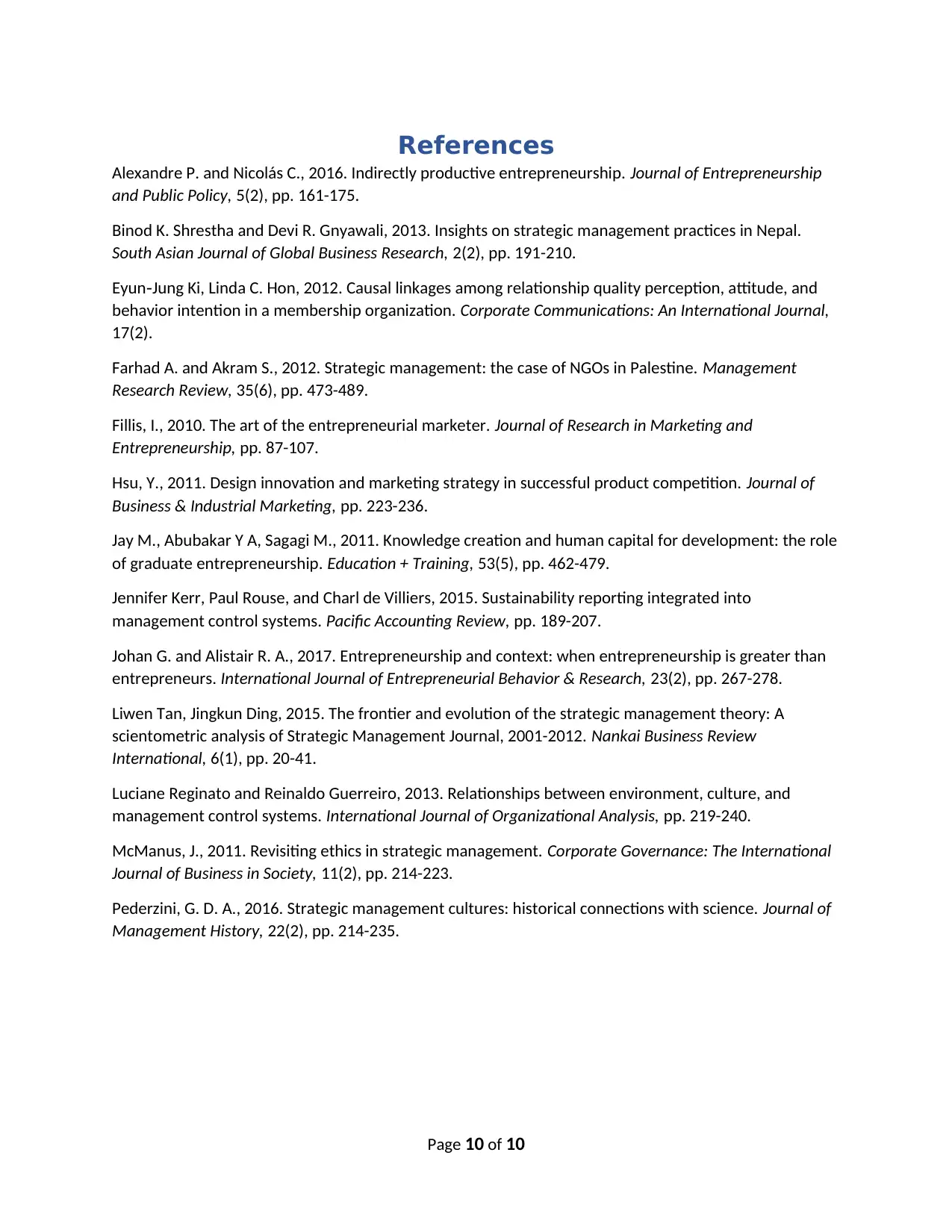
References
Alexandre P. and Nicolás C., 2016. Indirectly productive entrepreneurship. Journal of Entrepreneurship
and Public Policy, 5(2), pp. 161-175.
Binod K. Shrestha and Devi R. Gnyawali, 2013. Insights on strategic management practices in Nepal.
South Asian Journal of Global Business Research, 2(2), pp. 191-210.
Eyun Jung Ki, Linda C. Hon, 2012. Causal linkages among relationship quality perception, attitude, and‐
behavior intention in a membership organization. Corporate Communications: An International Journal,
17(2).
Farhad A. and Akram S., 2012. Strategic management: the case of NGOs in Palestine. Management
Research Review, 35(6), pp. 473-489.
Fillis, I., 2010. The art of the entrepreneurial marketer. Journal of Research in Marketing and
Entrepreneurship, pp. 87-107.
Hsu, Y., 2011. Design innovation and marketing strategy in successful product competition. Journal of
Business & Industrial Marketing, pp. 223-236.
Jay M., Abubakar Y A, Sagagi M., 2011. Knowledge creation and human capital for development: the role
of graduate entrepreneurship. Education + Training, 53(5), pp. 462-479.
Jennifer Kerr, Paul Rouse, and Charl de Villiers, 2015. Sustainability reporting integrated into
management control systems. Pacific Accounting Review, pp. 189-207.
Johan G. and Alistair R. A., 2017. Entrepreneurship and context: when entrepreneurship is greater than
entrepreneurs. International Journal of Entrepreneurial Behavior & Research, 23(2), pp. 267-278.
Liwen Tan, Jingkun Ding, 2015. The frontier and evolution of the strategic management theory: A
scientometric analysis of Strategic Management Journal, 2001-2012. Nankai Business Review
International, 6(1), pp. 20-41.
Luciane Reginato and Reinaldo Guerreiro, 2013. Relationships between environment, culture, and
management control systems. International Journal of Organizational Analysis, pp. 219-240.
McManus, J., 2011. Revisiting ethics in strategic management. Corporate Governance: The International
Journal of Business in Society, 11(2), pp. 214-223.
Pederzini, G. D. A., 2016. Strategic management cultures: historical connections with science. Journal of
Management History, 22(2), pp. 214-235.
Page 10 of 10
Alexandre P. and Nicolás C., 2016. Indirectly productive entrepreneurship. Journal of Entrepreneurship
and Public Policy, 5(2), pp. 161-175.
Binod K. Shrestha and Devi R. Gnyawali, 2013. Insights on strategic management practices in Nepal.
South Asian Journal of Global Business Research, 2(2), pp. 191-210.
Eyun Jung Ki, Linda C. Hon, 2012. Causal linkages among relationship quality perception, attitude, and‐
behavior intention in a membership organization. Corporate Communications: An International Journal,
17(2).
Farhad A. and Akram S., 2012. Strategic management: the case of NGOs in Palestine. Management
Research Review, 35(6), pp. 473-489.
Fillis, I., 2010. The art of the entrepreneurial marketer. Journal of Research in Marketing and
Entrepreneurship, pp. 87-107.
Hsu, Y., 2011. Design innovation and marketing strategy in successful product competition. Journal of
Business & Industrial Marketing, pp. 223-236.
Jay M., Abubakar Y A, Sagagi M., 2011. Knowledge creation and human capital for development: the role
of graduate entrepreneurship. Education + Training, 53(5), pp. 462-479.
Jennifer Kerr, Paul Rouse, and Charl de Villiers, 2015. Sustainability reporting integrated into
management control systems. Pacific Accounting Review, pp. 189-207.
Johan G. and Alistair R. A., 2017. Entrepreneurship and context: when entrepreneurship is greater than
entrepreneurs. International Journal of Entrepreneurial Behavior & Research, 23(2), pp. 267-278.
Liwen Tan, Jingkun Ding, 2015. The frontier and evolution of the strategic management theory: A
scientometric analysis of Strategic Management Journal, 2001-2012. Nankai Business Review
International, 6(1), pp. 20-41.
Luciane Reginato and Reinaldo Guerreiro, 2013. Relationships between environment, culture, and
management control systems. International Journal of Organizational Analysis, pp. 219-240.
McManus, J., 2011. Revisiting ethics in strategic management. Corporate Governance: The International
Journal of Business in Society, 11(2), pp. 214-223.
Pederzini, G. D. A., 2016. Strategic management cultures: historical connections with science. Journal of
Management History, 22(2), pp. 214-235.
Page 10 of 10
1 out of 10
Your All-in-One AI-Powered Toolkit for Academic Success.
+13062052269
info@desklib.com
Available 24*7 on WhatsApp / Email
![[object Object]](/_next/static/media/star-bottom.7253800d.svg)
Unlock your academic potential
Copyright © 2020–2025 A2Z Services. All Rights Reserved. Developed and managed by ZUCOL.


